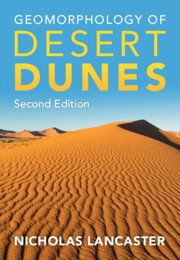Book contents
- Geomorphology of Desert Dunes
- Reviews
- Geomorphology of Desert Dunes
- Copyright page
- Contents
- Preface to the Second Edition
- Acknowledgments
- Part I Introduction and Fundamental Concepts
- Part II Dune Morphology and Sediments
- Part III Dune Processes and Dynamics
- 4 Sand Transport by Wind
- 5 Airflow and Sand Transport on Dunes
- 6 Dune Dynamics
- Part IV Boundary Conditions for Dune Formation and Development
- Part V Sand Seas and Dune Fields
- Part VI Dune Systems in Time and Space
- Part VII Conclusions
- References
- Index
- Plate Section (PDF Only)
4 - Sand Transport by Wind
from Part III - Dune Processes and Dynamics
Published online by Cambridge University Press: 03 March 2023
- Geomorphology of Desert Dunes
- Reviews
- Geomorphology of Desert Dunes
- Copyright page
- Contents
- Preface to the Second Edition
- Acknowledgments
- Part I Introduction and Fundamental Concepts
- Part II Dune Morphology and Sediments
- Part III Dune Processes and Dynamics
- 4 Sand Transport by Wind
- 5 Airflow and Sand Transport on Dunes
- 6 Dune Dynamics
- Part IV Boundary Conditions for Dune Formation and Development
- Part V Sand Seas and Dune Fields
- Part VI Dune Systems in Time and Space
- Part VII Conclusions
- References
- Index
- Plate Section (PDF Only)
Summary
Most dune sand is transported close to the surface by saltation and reptation of grains. The shearing action of the wind is resisted by grain size and shape, bed slope, moisture content, and surface roughness elements (especially the presence of vegetation). The relations between sand flux, particle size, aerodynamic roughness, slope, and wind shear velocity are complex, especially on dune surfaces, and may depart significantly from estimates derived from transport equations. The formation of wind ripples is intimately associated with the transport of sand by saltation and reptation, but the relationships between grain transport processes and the formation and development of ripples are complex, leading to a self-organizing pattern that responds rapidly to changes in sand flux and wind speed.
- Type
- Chapter
- Information
- Geomorphology of Desert Dunes , pp. 87 - 106Publisher: Cambridge University PressPrint publication year: 2023

